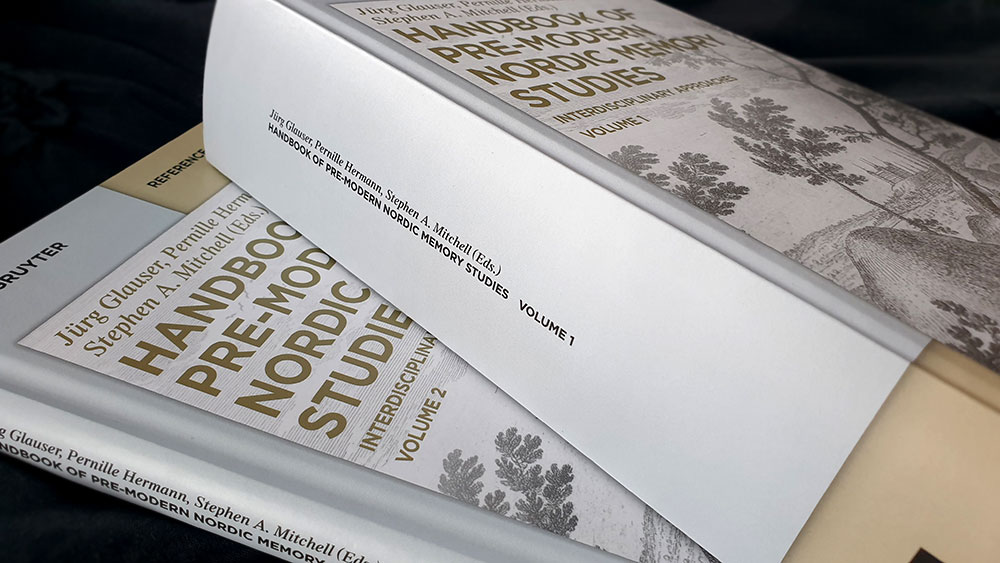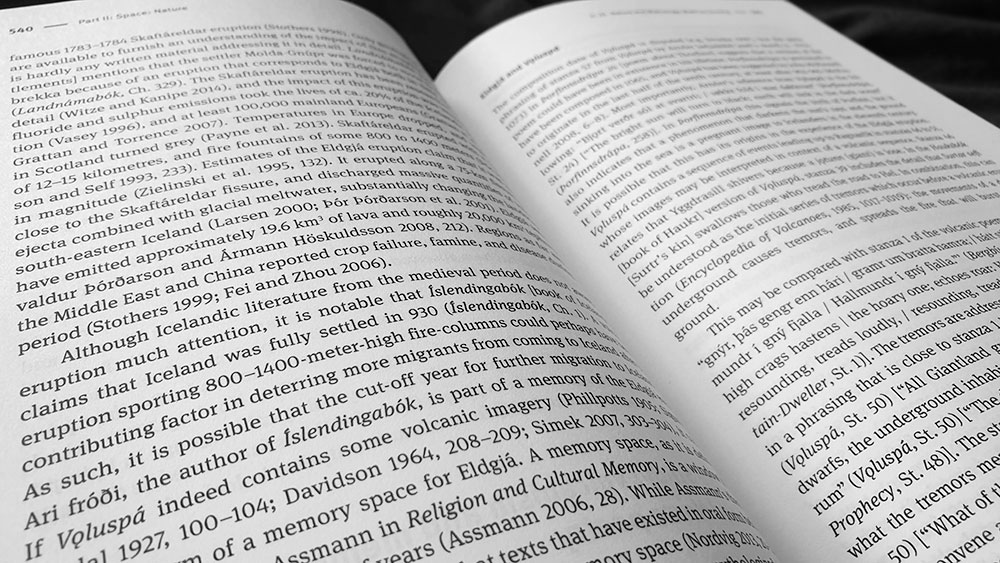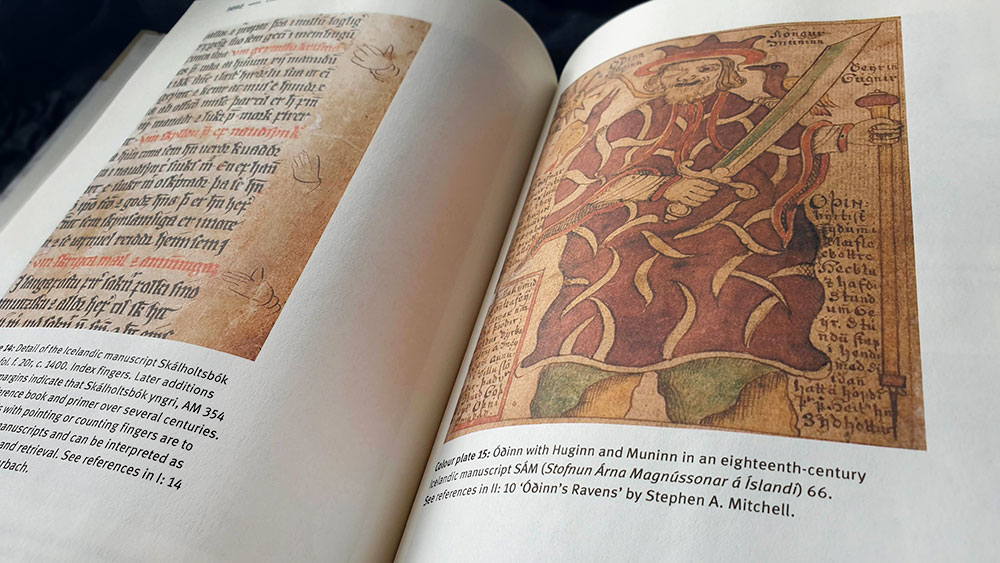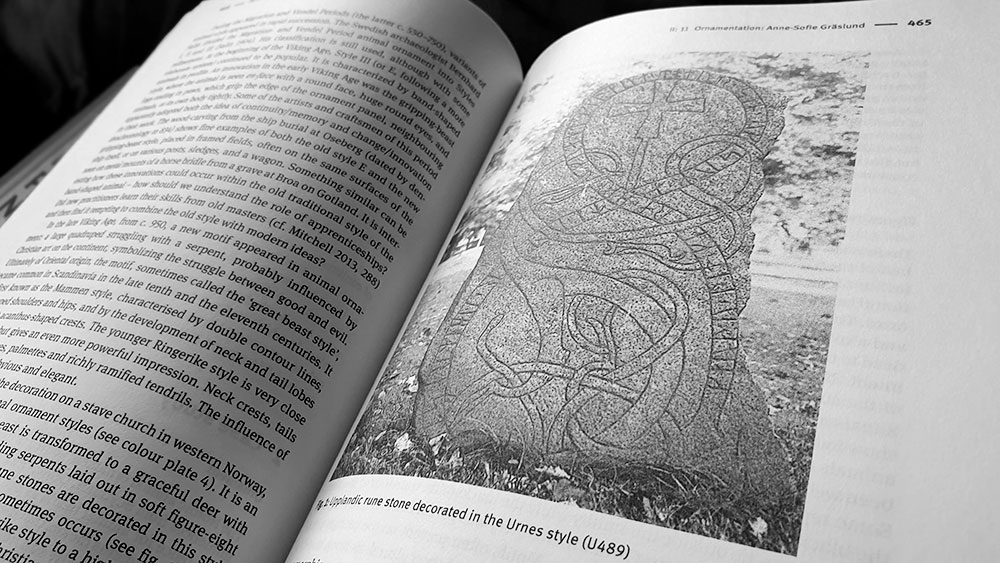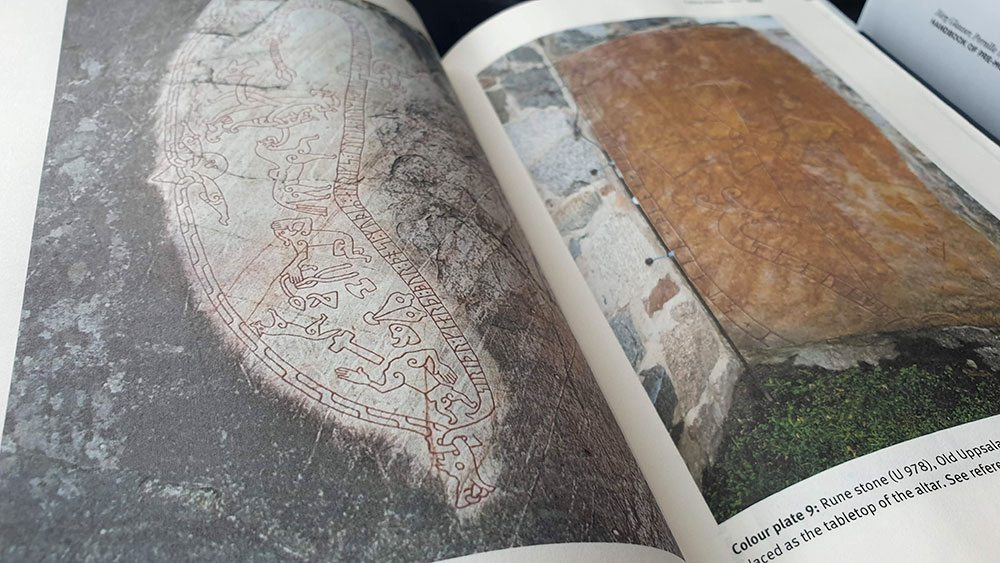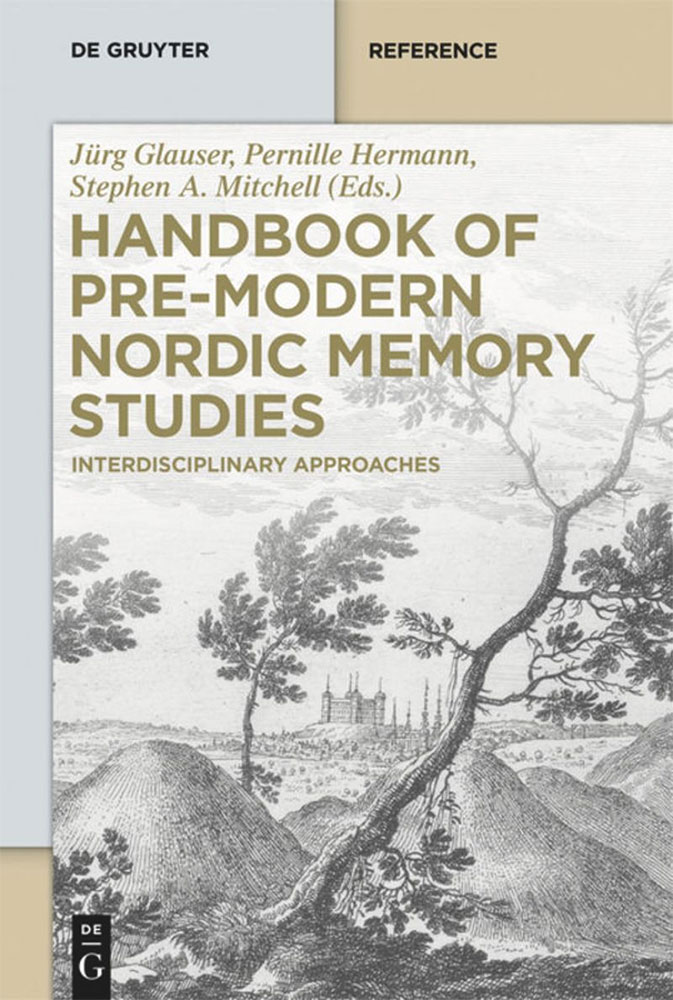 Divided into two volumes of a combined page count of well over 1000 pages, Handbook of Pre-Modern Nordic Memory Studies is a significant work, with the weighty tome of the first volume running to a cumbersome and intimidating 940 pages, while the second volume closes out this slightly misnamed ‘handbook’ with a considerably more manageable 214 pages. With entries documenting the work-to-date in the application of Memory Studies to what is rather broadly defined as the pre-modern Nordic world, this somewhat humbly titled handbook features approximately eighty contributors, some of whom have multiple entries, with many familiar names including Stephen A, Mitchell, John Lindow, Carolyne Larrington, Gísli Sigurðsson, Rudolf Simek, Terry Gunnell, Else Mundal, Terje Gansum, Thomas A. Dubois, Margaret Clunies Ross and Anne-Sofie Gräslund. While the focus is specifically on the Viking Age and the Middle Ages, as well both earlier and later periods, the net is also cast wider into neighbouring areas, such as in Sarah Künzler’s Celtic Studies and Antonina Harbus’ Anglo-Saxon Studies. There is also a significant section considering reflections on the Nordic past from different national perspectives beyond Scandinavia including North America (Birgitta Wallace, Stephen A. Mitchell and Henrik Williams), Britain and the Northern Isles (Joseph Falaky Nagy, Richard Cole and Mitchell again), as well as perspectives French (Pierre-Brice Stahl), German (Roland Scheel), Polish (Jakub Morawiec) and Russian (Ulrich Schmid and Barbora Davidková).
Divided into two volumes of a combined page count of well over 1000 pages, Handbook of Pre-Modern Nordic Memory Studies is a significant work, with the weighty tome of the first volume running to a cumbersome and intimidating 940 pages, while the second volume closes out this slightly misnamed ‘handbook’ with a considerably more manageable 214 pages. With entries documenting the work-to-date in the application of Memory Studies to what is rather broadly defined as the pre-modern Nordic world, this somewhat humbly titled handbook features approximately eighty contributors, some of whom have multiple entries, with many familiar names including Stephen A, Mitchell, John Lindow, Carolyne Larrington, Gísli Sigurðsson, Rudolf Simek, Terry Gunnell, Else Mundal, Terje Gansum, Thomas A. Dubois, Margaret Clunies Ross and Anne-Sofie Gräslund. While the focus is specifically on the Viking Age and the Middle Ages, as well both earlier and later periods, the net is also cast wider into neighbouring areas, such as in Sarah Künzler’s Celtic Studies and Antonina Harbus’ Anglo-Saxon Studies. There is also a significant section considering reflections on the Nordic past from different national perspectives beyond Scandinavia including North America (Birgitta Wallace, Stephen A. Mitchell and Henrik Williams), Britain and the Northern Isles (Joseph Falaky Nagy, Richard Cole and Mitchell again), as well as perspectives French (Pierre-Brice Stahl), German (Roland Scheel), Polish (Jakub Morawiec) and Russian (Ulrich Schmid and Barbora Davidková).
It would be impossible to discuss every entry lest this review run to the page-count of even the relatively humble second volume, but highlights are worth mentioning and the sections into which the books have been divided show the depth and breadth of what is considered here. Contributions are grouped into three parts, Part I: Disciplines, Traditions and Perspectives and Part II: Case Studies, with subcategories beneath each of these, while the standalone second volume consists of Part III: Text and Images.
In Part I, the discussions of disciplinary approaches to memory studies all follow a similar structure, intended to make the book unified and as pleasant to read as possible, beginning with a definition of the discipline and its intersection with memory studies, a survey of the current scholarship, a short exemplary study that demonstrates how memory studies can be applied to the field, a discussion of future directions more memory studies in that field, and finally a bibliography. These thirty entry are grouped into more precise categories beginning with Culture and Communication and flowing into sections on material culture, philology, aesthetics and communication, constructing the past, neighbouring disciplines and in-dialogue. Within this framework are a variety of considerations with notable examples being rhetoric and literary studies (Jürg Glauser), mythology (Pernille Hermann), the archaeology of mortuary architecture (Anders Andrén), performance (Terry Gunnell), folklore and orality (Stephen A. Mitchell), law (Stefan Brink), history (Bjørn Bandlien), popular culture (Jon Karl Helgason), and Kate Heslop’s Media Studies, in which she discusses the various media for communication of memory: stone, the body, wax and codex.
By their nature, these chapters are brief, not providing much to sink one’s teeth into, and instead the focus is a technical one, largely concerned with the study of studying, the teaching of teaching. That isn’t to say that the case studies included here are perfunctory, and of no wider interest, just that due to the format, they do have their limits. It is in the book’s second part that more in-depth considerations are presented as standalone investigations of these themes, though once again they aren’t as long as they might be in a different title.
Part II consists entirely of these case studies and they are intended to compliment and expand on the disciplinary-organised entries presented in the first section. There are seventy chapters in all, considering various memory-related texts, objects, practices, sites and other aspects of Viking and Medieval traditions, each presented as a self-contained two-part examination in which the specific theme is introduced, and then explored in a source-focused case study.
These studies are grouped under the broad categories of Media, Space, Action, and Power, with each having further subcategories for more specificity. The section of essays grouped under the heading of Media follow the approach established in Part I by Kate Heslop, and explore various medium that are further categorised under the subheadings of mediality, visual modes and narrating the past. Of these, some of the most interesting are Sarah Künzler’s discussion of skin, Karoline Kjesrud’s survey of Marian sculptures (whose ritual and devotional function placed them in a continuously dialogic relation with the past), Anne-Sofie Gräslund’s exploration of ornamentation in Scandinavian art, and Stephen A. Mitchell’s essay on perhaps the most obvious Nordic symbol of memory, Óðinn’s twin ravens Huginn and Muninn.
Pierre Nora’s concept of lieux de mémoire makes an obvious appearance amongst some of the contributions, though not as prominently as one might expect, particularly under the rubric of Space, which is delineated into two sub categories of nature and landscape. Lisa Bennett, for example, focuses on the depiction of burial mounds in Íslendingasögur, considering their mnemonic role in the landscape as both memorialising and commemorative, as well as the later cultural attitudes towards them as seen in their representations by the authors of the saga. Similar themes of mnemonic space are covered in contributions from Anni-Mari Hållans Stenholm in Landscapes and Mounds and Pernille Hermann in Memorial Landscapes, with the former discussing the role of the burial mound as the ultimate monument of memory, while the latter has a more specific focus in the Glavendrup rune stone. Another consideration of land as memory is from Mathias Nordvig who is very much in his wheelhouse when arguing, as he has done elsewhere, that a wide range of Nordic mythic imagery, particularly of the apocalyptic variety, is a memory of volcanic activity. As ever, though, Nordvig’s use of the natural allegory model is rather unrestrained in its application, with the result being that practically anything can be said to allude to volcanism.
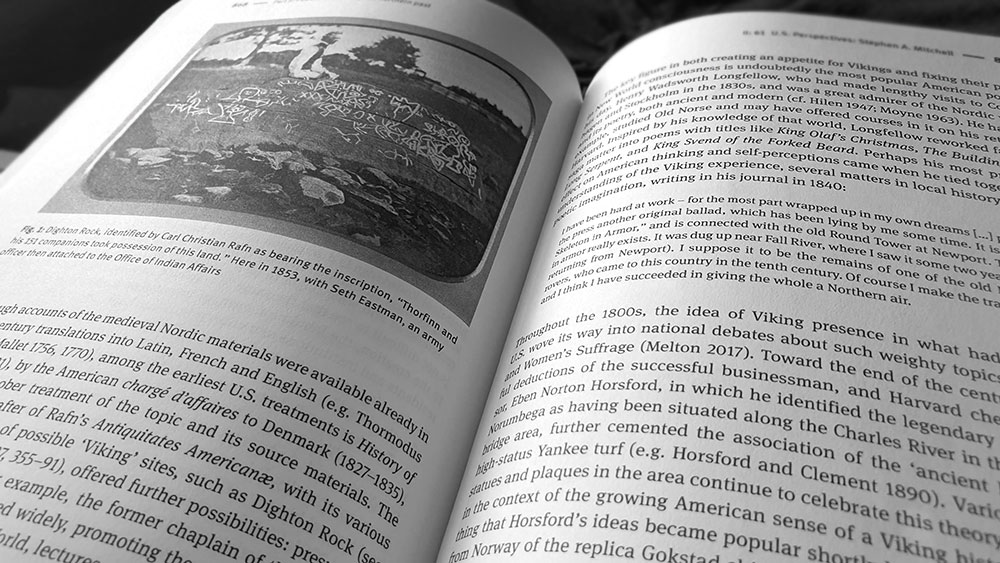 The essays grouped under the heading of Action have a focus on the crafting of memory, of performance and ritualised behaviour, and are further categorised by the subheadings of Using Specialist Knowledge and Performing Commemoration. The consideration of specialist knowledge begins with poetry, first in Russell Poole’s discussion of skalds as holders of cultural memory, highlighting their use of verse-forms such as dróttkvætt as a potential aid to their prodigious memory skills. Bergsveinn Birgisson also mentions the mnemonic properties of dróttkvætt but turns his focus to another area of Norse poetry, kennings, which, with their often bizarre visual imagery and use of contrast-tension, could have had a comparable function to the classical techniques of ars memoriae. Mnemonic devices are also of concern to Pernille Hermann in another entry here, while Gísli Sigurðsson looks at landscape as a memory tool in the form of mental maps, and Stephen Mitchell considers the role of memory in the use and transmission of charms in folk medicine. When the focus of Action turns to the theme of performative commemoration, these find form in discussions of ritual (Terry Gunnell), memorial poems and eulogies (Joseph Harris), memorial toasts (Lars Lönnroth), Faroese chain dancing (Tóta Árnadóttir), while Agnes S. Arnórsdóttir has two contributions, one on the role of women in remembrance practices, and another on post-conversion donation culture. The one outlier here is another piece by Mathias Nordvig but with a modern focus, discussing the use of the figure of the Viking as a racial patriarch in the contemporary identitarian Asatru of two groups, the Asatru Folk Assembly and the Wolves of Vinland.
The essays grouped under the heading of Action have a focus on the crafting of memory, of performance and ritualised behaviour, and are further categorised by the subheadings of Using Specialist Knowledge and Performing Commemoration. The consideration of specialist knowledge begins with poetry, first in Russell Poole’s discussion of skalds as holders of cultural memory, highlighting their use of verse-forms such as dróttkvætt as a potential aid to their prodigious memory skills. Bergsveinn Birgisson also mentions the mnemonic properties of dróttkvætt but turns his focus to another area of Norse poetry, kennings, which, with their often bizarre visual imagery and use of contrast-tension, could have had a comparable function to the classical techniques of ars memoriae. Mnemonic devices are also of concern to Pernille Hermann in another entry here, while Gísli Sigurðsson looks at landscape as a memory tool in the form of mental maps, and Stephen Mitchell considers the role of memory in the use and transmission of charms in folk medicine. When the focus of Action turns to the theme of performative commemoration, these find form in discussions of ritual (Terry Gunnell), memorial poems and eulogies (Joseph Harris), memorial toasts (Lars Lönnroth), Faroese chain dancing (Tóta Árnadóttir), while Agnes S. Arnórsdóttir has two contributions, one on the role of women in remembrance practices, and another on post-conversion donation culture. The one outlier here is another piece by Mathias Nordvig but with a modern focus, discussing the use of the figure of the Viking as a racial patriarch in the contemporary identitarian Asatru of two groups, the Asatru Folk Assembly and the Wolves of Vinland.
The final grouping of essays considers memory through power under the three further classifications of Designing Beginnings, National Memories, and Envisioning the Northern Past, providing insight, as the headings suggest, into how memory has a foundational capability that can be used to define imagined communities and societies. Of these, highlights are those discussing national perspectives on the Nordic past, with various authors showing how that mythic strata was used in crafting the identity of different Scandinavian nations. Both Pernille Hermann and Sophie Bønding look at things from a Danish perspective, Malan Marnersdóttir discusses the impact of Færeyinga Saga on Faroese identity, while Norway is covered separately by Terje Gansum and Jon Gunnar Jørgensen, and Sweden by both Stephen Mitchell and Anna Wallette, with the latter focusing on the role of Olaus Rudbeck and his unashamedly suecophilic book Atlantica.
The separate second volume of Handbook of Pre-Modern Nordic Memory Studies takes a different approach to the consideration of memory with Part III: Text and Images beginning not with essays but with source texts, and thereby giving the reader, be they experienced or lay, the opportunity to see for themselves how concerns of memory are dealt with in this corpus of pre-Modern Nordic material. With content both mystical and prosaic, stretching from Völuspá to a lost land deed from 1420-1474’s Stockholm Land Registry, as well as the inscriptions of runestones, each entry is presented with an often slight introductory comment, data on the text’s name, source and translation, and then the excerpt itself in its original language followed by an English translation. As the introduction from editors Glauser, Hermann and Mitchell presents it, these excerpts give the reader a direct experience with the Old Norse concepts of minni, free of any editorialising. The latter half of Volume 2 reflects the visual component alluded to in the Text and Images title, with a collection of colour plates, twenty-six in all, featuring images referenced in Volume 1’s previous first and second parts. It’s a valuable and ultimately logical adjunct, given the page count of the first volume but something of a pain if you’re reading the essays and need to keep this second book on hand too in order to check any visual references.
Despite its intimidating length, Handbook of Pre-Modern Nordic Memory Studies can feel like an easy read, with most contributions never going beyond ten pages, and usually coming in at far less, meaning that if something doesn’t grab your attention, it doesn’t take long to breeze through it and move on to the next one. With the cast of recognisable names from Nordic academic, there’s a quality and expertise to the writing, making both volumes a worthy, if heavy, addition to one’s library.
Published by De Gruyter
